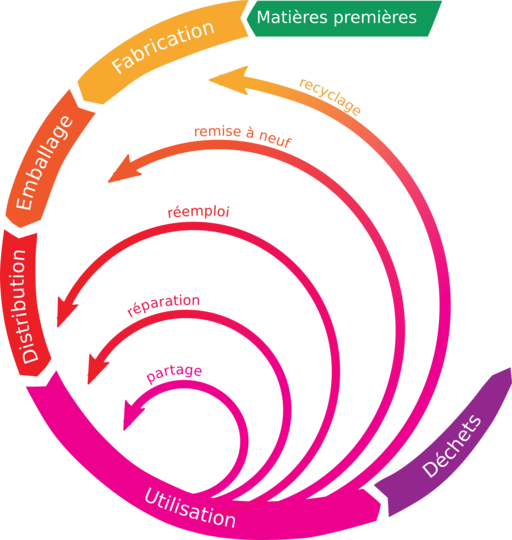What are the limits of the circular economy?¶
Authors and date
- Submitted on: July 7th 2021
- Guillaume Mandil; Research professor UGA, UFR PhITEM, Inria team STEEP
This sheet, automatically translated by the Deepl tool, has not been proofread by its author
What is the circular economy?¶
According to Wikipedia: "The circular economy is a new economic model with a systemic vision. The concepts of green economy, economy of use or economy of functionality, performance economy and industrial ecology are part of the circular economy.
Such an economy operates in a loop (see Figure 1), thus dispensing with the notion of "waste". Its objective is to produce goods and services while strongly limiting the consumption and waste of raw materials and non-renewable energy sources.
As shown in Figure 1, the main strategies for implementing the circular economy are sharing, repair, reuse, refurbishment and recycling. Examples of the implementation of these strategies are described in concept sheet "The 5R of digital technology"concept sheet "The 5R of digital technology" .
Figure 1: Circular economy (source: G.Mannaerts, CC BY-SA 4.0, Wikimedia Commons)
This concept is often presented, with good reason, as a strategy to reduce environmental impacts. Indeed, if the production and consumption of goods in the economy remains constant, the more circular it is, the less virgin raw materials need to be extracted or waste needs to be disposed of. According to the definition of environmental impacts, these are generated by withdrawals or discharges into the environment.
The limits of circular ecology¶
Nevertheless, this strategy has its limits.
On the one hand, in a growing economy, even a 100% circular economy is not able to supply the entire resource demand of the economy1 because this demand grows while resources are in use in an economic cycle (see Figure 2). To supply the increase in this demand, it is therefore always necessary to obtain virgin primary resources. Figure 2 gives the example of a resource with a lifetime in the economy of 4 years and increasing demand. The orange arrow shows the amount of this resource that would be produced by recycling if recycling were 100% efficient. The green arrow shows the amount that would be produced by a 25% recycling. We can see here that recycling is not sufficient to ensure the production to cover the totality of the demand for this resource. This is particularly true for the metals needed to manufacture digital infrastructures, where recycling rates are mostly below 40% (except for iron/steel, where the recycling rate is generally above 80%).
Figure 2: The limits of recycling in a context of growing demand (adapted from a figure by Françoise Berthoud)
On the other hand, it cannot be ruled out that the implementation of a circular economy strategy will generate a rebound effect (see concept sheet "The rebound effect"concept sheet "The rebound effect" ). Indeed, the circular economy is a strategy to improve the efficiency of the use of virgin resources by economic cycles. Efficiency gains that are the main cause of generating a rebound effect.
For the 2 reasons above, it is therefore important to keep in mind that increasing the circularity rate of the economy is not a strategy that guarantees a reduction of environmental impacts. strategy that guarantees a reduction in environmental impacts. However, if we manage to limit growth and rebound effects, the circular economy can be an interesting strategy.
Sources¶
-
François Grosse. Les limites du recyclage dans un contexte de demande croissante de matières premières. Annales des Mines - Responsabilité et environnement, 2014/4 (N° 76), p. 58-63. DOI 10.3917/re.076.0058 ↩

